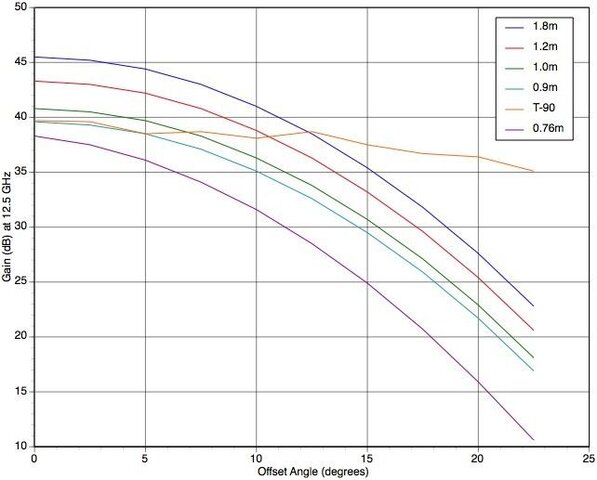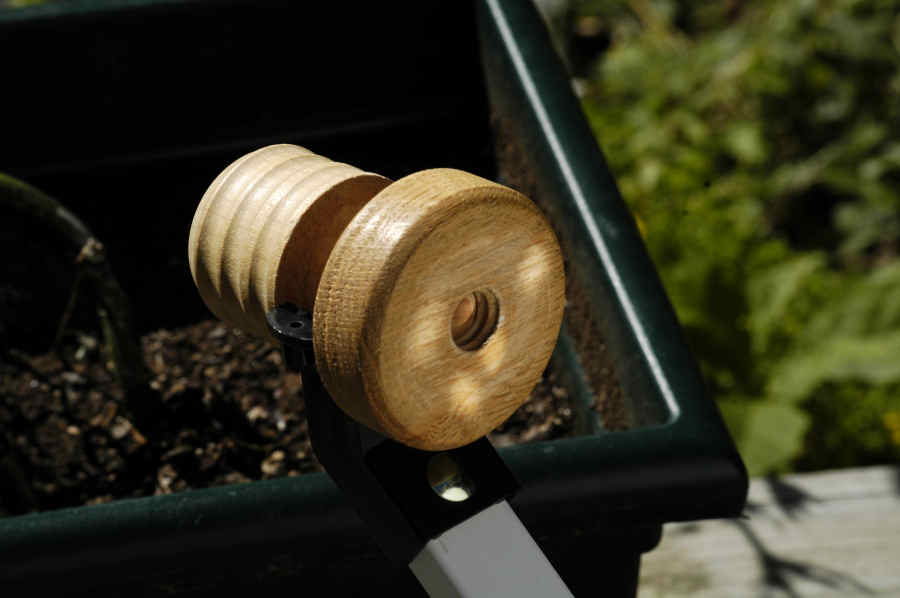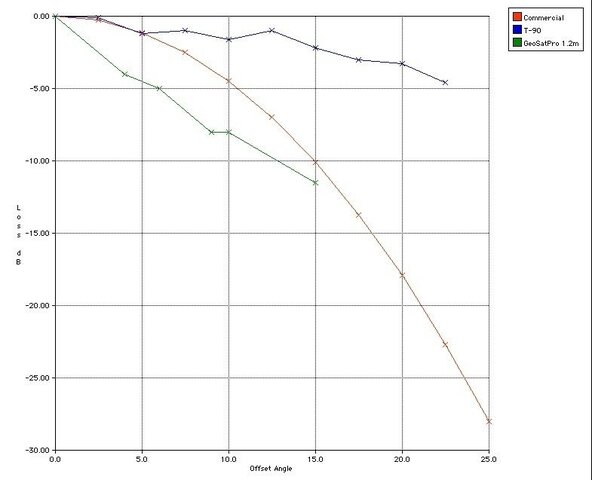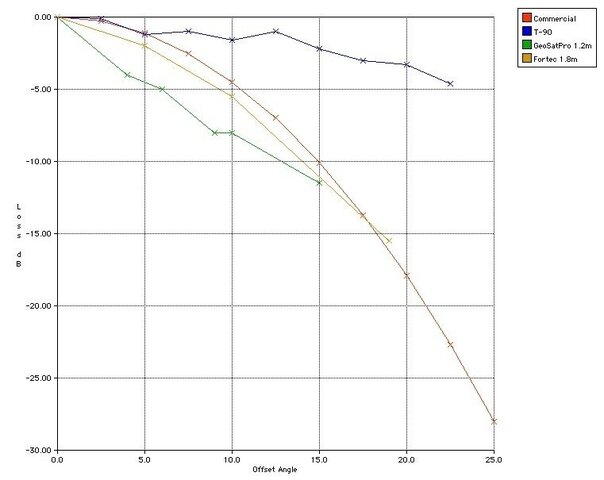There is a very interesting thread running in this forum concerning linuxman's project to capture multiple satellites:
I've also been contemplating this for awhile to reduce the competition of our family for the motorized dishes in our farm. With all the choices available, my interest lies in analytically determining a feasible design for a given set of birds/transponders before I pick up the tools in the shop. Rather than hijacking the original thread, I thought it better to start a new one summarizing what I have measured and learned. This is a work in progress as I've found a lot of myths, snake oil and much less hard science than I would like. I will be happy to correct any of my errors that are pointed out.
My first step was to consider what could be done with ordinary parabolic dishes. Parabolic dishes show very little loss (< 1 dB) for a feed off-axis by a few degrees. After that the drop-off accelerates. I didn't find a lot of useful data, but afcsat.com had some info I was able to spot check against a few other scattered points across the web. The agreement was also close for a few measurements I made for a rather unrelated project I am working on for my 3m. I've done a crude data fit and calculated the off-axis gains for several dish sizes in the Ku band. To correlate the relative performance, I've compared several vendors' specs and direct measurements on my dishes. The differences were mostly on the order of 0.5 dB and shouldn't have much effect on the bottom line.
My examples were:
1. 1.8m Fortec prime-focus
2. 1.2m GeoSatPro offset (also compared a Fortec 1.2m)
3. 1m Winegard DS-3100 offset
4. 90cm GeoSatPro (also compared a Fortec 90cm)
5. 76cm Winegard DS-2077 offset
The off-axis gains are plotted on the attachment as five of the six lines. The on-axis gain is that stated by the vendor, and checked for 1,2 and 5 as I have those dishes. The off-axis loss was calculated from my fit to the paucity of data available. The curves are only rough, but I think they are representative out to about 10-15 degrees. Realize that a parabolic antenna can only point focus on-axis. Any off-axis source will exhibit coma, and this will increase as one goes further off-axis. After that the defocussing will become messier and less subject to analysis; I wouldn't be surprised if these curves are on the fairly optimistic side.
In summary the fit predicts the gain will be 3dB down at about 8 degrees off-axis, and 10dB at about 15 degrees. That means even a 1.8m dish would be only be the equivalent of a 76cm dish (on-axis) at around 13 degrees. I didn't find this encouraging because the bulk of the FTA channels we watch are tending towards high SRs, high FECs and DVB-S2 over time. I would like to have enough margin for that.
Toroidal dishes represent an alternative geometry that offers the possibility of a broader arc of possible reception. After reading Iceberg's extended review thread of the Wave Frontier T-90, I located one of these for a reasonable price. I was a bit dubious of WF's claim of 40 degree arcs, so I decided to run a series of detailed tests to find out how it actually performs.
According to WF, the gain of a T-90 is comparable to a 90cm parabolic. This is possible because it has considerably more surface area, but I decided to check it. Trying to measure this within fractions of a dB seemed a bit onerous, but after thinking about it I decided to hold as many variables constant as I could. We're also DN subscribers and I already had several 76cm pointed and peaked at 61.5, 110, 119 and 129. The problem with comparing the T-90 is that as it has two reflective surfaces, circularly polarized signals are flipped compared to a single reflector. I could have used linear for the comparison, but CP signals average better and I wouldn't have to move the 76cm dishes.
My plan was to peak the T-90 on a DN bird, measure several transponders on my spectrum analyzer and then move the LNBF and cable over to a 76cm dish. To factor out any frequency dependent gains/losses, I wanted a LNBF I could quickly convert from normal CP polarity to reverse CP polarity. So I popped a DP dual LNBF apart and proved to my satisfaction that rotating the dielectric plate could give results accurate to 0.5 dB or better as long as I used the same output.
After running the tests, the T-90 measured about 0.7dB gain over the 76cm dishes. That's not amazing, but WF's spec is only 1dB more than Winegard's, so given my measurement errors, I'll give them the benefit of the doubt.
As it got dark I then ran the LNBF from 0-22.5 degrees offset in steps of 2.5 on the T-90. At each point I skewed the dish to the predicted center and then peaked the elevation and azimuth on the same bird. It would have been nice to repeat the measurements several times and at more points, but I only wanted numbers good enough for design purposes and I also couldn't hold up dinner. So the data I plotted on the graph for the T-90 may be a little ragged. Nevertheless a real-life gain profile is not going to be a smooth curve.
Eyeballing the results indicates the T-90 does not exhibit the rapid fall-off of a parabolic. In fact at 12 degrees off-axis and beyond, it beats a 1.8m. Still at 20 degrees it is 3dB down and well below a 76cm on-axis in terms of performance. Although WF doesn't directly say this, one can imply it is from their spec of 40 degree arcs.
One positive that didn't immediately occur to me but was borne out as I moved a linear LNBF across an arc of a tuned T-90, was the angular beamwidth is tighter than a 90cm dish in-track. I saw very little spillover from adjacent 2 degree spaced satellites on the spectrum analyzer. Probably this is because the in-track dish dimension is nearly 1.1m. The cross-track beamwidth probably isn't as good, but who cares? This bodes well for nailing a series of Ku birds at 2 degree separations. I am testing modified Superdish 105 and 121 feeds to accomplish this without having to grind down the LNBFs, but that is another project.
While I had hoped for a little better performance on the toroid, my measurements do validate the specs. I'll probably restrict its use to around 30 degrees of arc. I am also considering using an extra 1.2m I have lying around, or possibly picking up another 1.8m, but the useful arc for me would only be around 20 degrees.
I hope these data will prove useful to others looking at multi-satellite reception.
I got the bright idea the other day to make an attempt at getting as much of the Ku arc viewable from North America as possible using fixed Ku dishes and multi-lnbfs.
I've also been contemplating this for awhile to reduce the competition of our family for the motorized dishes in our farm. With all the choices available, my interest lies in analytically determining a feasible design for a given set of birds/transponders before I pick up the tools in the shop. Rather than hijacking the original thread, I thought it better to start a new one summarizing what I have measured and learned. This is a work in progress as I've found a lot of myths, snake oil and much less hard science than I would like. I will be happy to correct any of my errors that are pointed out.
My first step was to consider what could be done with ordinary parabolic dishes. Parabolic dishes show very little loss (< 1 dB) for a feed off-axis by a few degrees. After that the drop-off accelerates. I didn't find a lot of useful data, but afcsat.com had some info I was able to spot check against a few other scattered points across the web. The agreement was also close for a few measurements I made for a rather unrelated project I am working on for my 3m. I've done a crude data fit and calculated the off-axis gains for several dish sizes in the Ku band. To correlate the relative performance, I've compared several vendors' specs and direct measurements on my dishes. The differences were mostly on the order of 0.5 dB and shouldn't have much effect on the bottom line.
My examples were:
1. 1.8m Fortec prime-focus
2. 1.2m GeoSatPro offset (also compared a Fortec 1.2m)
3. 1m Winegard DS-3100 offset
4. 90cm GeoSatPro (also compared a Fortec 90cm)
5. 76cm Winegard DS-2077 offset
The off-axis gains are plotted on the attachment as five of the six lines. The on-axis gain is that stated by the vendor, and checked for 1,2 and 5 as I have those dishes. The off-axis loss was calculated from my fit to the paucity of data available. The curves are only rough, but I think they are representative out to about 10-15 degrees. Realize that a parabolic antenna can only point focus on-axis. Any off-axis source will exhibit coma, and this will increase as one goes further off-axis. After that the defocussing will become messier and less subject to analysis; I wouldn't be surprised if these curves are on the fairly optimistic side.
In summary the fit predicts the gain will be 3dB down at about 8 degrees off-axis, and 10dB at about 15 degrees. That means even a 1.8m dish would be only be the equivalent of a 76cm dish (on-axis) at around 13 degrees. I didn't find this encouraging because the bulk of the FTA channels we watch are tending towards high SRs, high FECs and DVB-S2 over time. I would like to have enough margin for that.
Toroidal dishes represent an alternative geometry that offers the possibility of a broader arc of possible reception. After reading Iceberg's extended review thread of the Wave Frontier T-90, I located one of these for a reasonable price. I was a bit dubious of WF's claim of 40 degree arcs, so I decided to run a series of detailed tests to find out how it actually performs.
According to WF, the gain of a T-90 is comparable to a 90cm parabolic. This is possible because it has considerably more surface area, but I decided to check it. Trying to measure this within fractions of a dB seemed a bit onerous, but after thinking about it I decided to hold as many variables constant as I could. We're also DN subscribers and I already had several 76cm pointed and peaked at 61.5, 110, 119 and 129. The problem with comparing the T-90 is that as it has two reflective surfaces, circularly polarized signals are flipped compared to a single reflector. I could have used linear for the comparison, but CP signals average better and I wouldn't have to move the 76cm dishes.
My plan was to peak the T-90 on a DN bird, measure several transponders on my spectrum analyzer and then move the LNBF and cable over to a 76cm dish. To factor out any frequency dependent gains/losses, I wanted a LNBF I could quickly convert from normal CP polarity to reverse CP polarity. So I popped a DP dual LNBF apart and proved to my satisfaction that rotating the dielectric plate could give results accurate to 0.5 dB or better as long as I used the same output.
After running the tests, the T-90 measured about 0.7dB gain over the 76cm dishes. That's not amazing, but WF's spec is only 1dB more than Winegard's, so given my measurement errors, I'll give them the benefit of the doubt.
As it got dark I then ran the LNBF from 0-22.5 degrees offset in steps of 2.5 on the T-90. At each point I skewed the dish to the predicted center and then peaked the elevation and azimuth on the same bird. It would have been nice to repeat the measurements several times and at more points, but I only wanted numbers good enough for design purposes and I also couldn't hold up dinner. So the data I plotted on the graph for the T-90 may be a little ragged. Nevertheless a real-life gain profile is not going to be a smooth curve.
Eyeballing the results indicates the T-90 does not exhibit the rapid fall-off of a parabolic. In fact at 12 degrees off-axis and beyond, it beats a 1.8m. Still at 20 degrees it is 3dB down and well below a 76cm on-axis in terms of performance. Although WF doesn't directly say this, one can imply it is from their spec of 40 degree arcs.
One positive that didn't immediately occur to me but was borne out as I moved a linear LNBF across an arc of a tuned T-90, was the angular beamwidth is tighter than a 90cm dish in-track. I saw very little spillover from adjacent 2 degree spaced satellites on the spectrum analyzer. Probably this is because the in-track dish dimension is nearly 1.1m. The cross-track beamwidth probably isn't as good, but who cares? This bodes well for nailing a series of Ku birds at 2 degree separations. I am testing modified Superdish 105 and 121 feeds to accomplish this without having to grind down the LNBFs, but that is another project.
While I had hoped for a little better performance on the toroid, my measurements do validate the specs. I'll probably restrict its use to around 30 degrees of arc. I am also considering using an extra 1.2m I have lying around, or possibly picking up another 1.8m, but the useful arc for me would only be around 20 degrees.
I hope these data will prove useful to others looking at multi-satellite reception.






